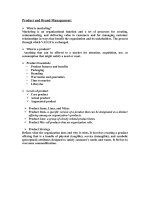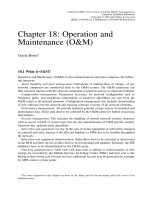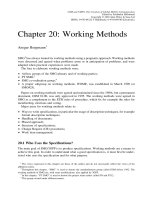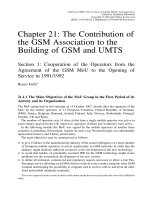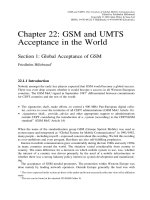Tài liệu GSM and UMTS (P18) doc
Bạn đang xem bản rút gọn của tài liệu. Xem và tải ngay bản đầy đủ của tài liệu tại đây (41.47 KB, 5 trang )
Chapter 18: Operation and
Maintenance (O&M)
Gisela Hertel
1
18.1 What is O&M?
Operation and Maintenance (O&M) of telecommunications networks comprises the follow-
ing functions:
Alarm handling and fault management: Indications of malfunctions or outages of any
network component are transferred back to the O&M system. The O&M technician can
then remotely interact with the network component in question and try to repair the problem.
Configuration management: Parameters necessary for network configuration such as
frequency plans, next-neighbour relationships or handover algorithms are sent from the
O&M centre to all network elements. Configuration management also includes downloading
of new software into the network and tracking software versions of all network elements.
Performance management: All network elements generate a large variety of statistical and
performance data. These data need to be collected by the O&M centre for further processing
and analysis.
Security management: This includes the handling of normal network security measures
such as access control or system logs, but also the administration of GSM specific security
functions like authentication algorithms.
Subscriber and equipment tracing: In the case of stolen equipment or subscribers engaged
in criminal activities, tracing of the affected handsets or SIMs has to be feasible throughout
the network.
Subscriber and equipment administration: Subscribers have to be activated or deactivated
in the HLR and their service profiles have to be downloaded and updated. Similarly, the EIR
databases have to be administrated by the O&M centre.
Charging administration: After each call, data such as calling or called number or time
stamps are recorded by the Mobile-Services Switching Centre (MSC) and later sent to the
billing system. In the case of some services, additional records may be generated for example
by SMS centres or data nodes.
1
The views expressed in this chapter are those of the author and do not necessarily reflect the views of his
affiliation entity.
GSM and UMTS: The Creation of Global Mobile Communication
Edited by Friedhelm Hillebrand
Copyright q 2001 John Wiley & Sons Ltd
ISBNs: 0-470-84322-5 (Hardback); 0-470-845546 (Electronic)
18.2 Why Standardise O&M Functions?
All the functions described above involve data transfer between network elements and the
O&M centre, or between the billing system and databases in the Home Location Register
(HLR), Authentication Centre (AuC) and Equipment Identity Register (EIR). It is not strictly
necessary to standardise these interfaces. Mobile stations and networks need to interact with
each other in a standardised manner world-wide to allow roaming, but O&M centres and
billing systems are ‘‘ hidden’’ in each network, and have no connection with foreign network
elements. Internal operations within each GSM system can be considered a matter of each
individual operator.
The push to standardise O&M functions came from the network operators: they wanted the
freedom to mix equipment of different vendors throughout their networks.
In a multi-vendor environment, integrated O&M functionality is absolutely necessary: the
operator needs to collect performance data from base stations throughout the network, and the
data need to be comparable. Frequency plans need to be downloaded to all base stations, and
adjacent base stations need to be configured to hand traffic to each other, even if they are not
made by the same manufacturer. And security management of course needs to work seam-
lessly throughout the system.
Before GSM, incumbent network operators often had long-term supplier relationships with
equipment manufacturers, who were very familiar with the operation of the national fixed or
mobile networks. Each new network element was duly connected to the existing O&M
centre, mostly through proprietary interfaces. It was not conceivable for these interfaces to
be made available to other vendors.
Many new GSM operators however started with a clean slate and wanted to get maximum
value from their suppliers. This was only possible by buying whatever equipment best fits
their needs at any given time without being tied into a permanent relationship with any
supplier.
Many of the equipment manufacturers of course did not favour such a development:
opening up proprietary O&M interfaces to competitors, or implementing fully standardised
interfaces made their key customer relationships vulnerable.
One aspect of O&M standardisation however was never disputed: The need for all MSCs to
provide identical parameters in the call detail records was recognised by everybody without
argument. The call detail records are used for charging, and tariff plans can only use those
parameters contained in the records. An operator cannot charge for a service, if only one of
his vendors makes the appropriate charging parameters available, or if charging parameters
vary throughout the network.
In addition, the call and event records contained in the O&M specification GSM 12.05 are
used as an input for the transferred account records defined by MoU for the charging proce-
dures of roaming calls. If a parameter is not available in GSM 12.05, it cannot be included
into the transferred account procedure and can therefore not be used as a basis for roaming
tariffs between operators.
There was another reason why O&M gained more attention as GSM started growing. The
analogue networks existing before GSM were quite small and not much effort was required
for monitoring the infrastructure by the incumbent operators who had large numbers of
skilled O&M staff. But the larger GSM networks soon had thousands of base stations, all
of which sent out alarms, created performance data and needed configuration.
GSM and UMTS: The Creation of Global Mobile Communication446
Efficient O&M systems started playing a much larger role in providing good service
quality and optimising operational costs. This trend was amplified by the fact that the new
private GSM operators lacked experienced O&M technicians, and therefore needed intelli-
gent O&M systems. In addition, the incumbent operators were coming under increased
pressure from the new competitors, and also tried to limit their operational cost.
18.3 The Elaboration of the GSM Phase 1 O&M Specifications
Originally a group called the Operations and Maintenance Expert Group (OMEG) existed
within GSM. This group was chaired by Bernd Haarpaintner until March 1991, and by Gisela
Hertel after that date. At the second SMG plenary in March 1992, OMEG was elevated to full
GSM sub-technical committee status and renamed SMG6.
At the beginning, work in SMG6 was quite difficult. The operators, particularly the new
private operators had a clear interest in comprehensive O&M standards to enable multi-
vendor networks, but they lacked the extensive resources necessary for completing the
technically very challenging O&M specifications. The manufacturers did have signifi-
cantly better resources, but they were much less enthusiastic about O&M standards to
begin with.
One of the key players during this phase was George Schmitt, then chairman of the GSM
MoU association and also technical director of one of the largest private operators, Mannes-
mann Mobilfunk. He wielded his considerable influence to make sure that manufacturers took
O&M issues seriously and contributed to SMG6. George’s intervention turned out to be
somewhat of a double-edged sword. On one hand SMG6 certainly got everybody’s attention
and better resources, but on the other hand manufacturers active in SMG6 still had a dilemma.
As soon as O&M standards would be stable, operators would demand their implementation.
But they had already installed legacy O&M centres developed before standardisation in most
networks.
But in the end, a BSS oriented set of O&M specifications for phase 1 was approved in
1991/2. Many companies and individuals contributed to this comprehensive set of standards,
but Hans Hauser and his colleagues from T-Mobil deserve special recognition: T-Mobil
provided a large team of experts to SMG6 and took responsibility for several key O&M
specifications.
The finalisation of these phase 1 specifications was a source of considerable pride and
satisfaction among all SMG6 members. To understand this, one has to realise the complexity
of standardising the O&M interfaces described at the beginning of this chapter: Every time a
new feature or service is introduced into GSM, or every time a protocol is updated, the O&M
messages need to be modified too. Any new service needs to be activated in the HLR and may
need additional parameters in the call data records. Performance data have to be collected to
evaluate the usage of the service, and configuration management may be affected. Also,
O&M messages may have to be modified to accommodate additional alarms or fault manage-
ment actions. Security management has to be reviewed, and subscriber and equipment tracing
may have to be updated.
To complete these consistency checking exercises, SMG6 needed the support of PT 12,
most likely to a much larger extent than any other STC. Fortunately, support was provided
willingly and competently throughout the entire lifetime of SMG6 by Jonas Twingler, Elmar
Grasser, Marion Hoenicke, Michael Sanders and Ansgar Bergmann.
Chapter 18: Operation and Maintenance 447
Another consequence of the tight link between O&M and all other GSM specifications is
an inevitable delay of O&M specifications: They could only be finalised about 6–9 months
after the core specifications were stable, because this time was necessary to incorporate all
core features into the O&M functionality.
Despite the sense of accomplishment felt after the finalisation of phase 1 specifications, the
impact of these standards on the actual GSM world was quite minimal: Due to the late
timeframe, O&M systems unaffected by the new standards were largely up and running
throughout the GSM world.
18.4 The Elaboration of the GSM Phase 2 O&M Specifications
The situation changed for phase 2 which for SMG6 came not too long after phase 1. The
complete set of phase 2 O&M specifications was approved in the summer of 1996, 9 months
after the freezing of phase 2 core specifications in October 1995 and within the planned
schedule. The only exception was the work on subscriber and equipment tracing which had
started late in the process and was not completed until the spring of 1997.
In phase 2, work in SMG6 had become much easier. The big battles of the beginning
(which had in hindsight been very useful to define a clear road for O&M standardisation) had
subsided, efficient working and decision procedures had evolved and again PT 12 provided
exemplary technical and administrative support. In addition, phase 1 specifications had been
completed not long before and therefore were quite up to date and provided an excellent basis
to work on.
The relevance of phase 2 O&M specifications for the industry was considerably higher
than in phase 1. First, the standards were available in a much more timely manner relative to
the core specifications, and both operators and manufacturers were much more aware of
O&M issues than before. Phase 2 O&M standards were probably not implemented to the
letter anywhere in the GSM world, but manufacturers took them into consideration for their
new O&M releases, and operators had a better framework to stand on in contract negotia-
tions.
Another issue discussed during phase 2 was the extension of the O&M specifications from
the radio subsystem to also include the MSC or related components such as HLR, VLR, EIR
or AuC. There was considerable interest in such work, particularly from the operators, but in
the end a lack of resources resulted in maintaining the existing scope. MSCs differ much more
strongly from vendor to vendor than the radio subsystem, and standardised O&M architec-
tures would have been very difficult. In addition, most of the alarms, faults, performance and
configuration parameters are generated by the radio subsystem, so it is most efficient to
concentrate standardisation efforts there.
18.5 The Elaboration of the GSM Phase 21 O&M Specifications
The updating of O&M specifications in phase 21 proceeded in the same smooth manner as
described for phase 2, and phase 21 O&M standards were completed within the targeted 6–9
months after stabilisation of the corresponding core specification release packages.
The most significant new addition during phase 2 was a new specification describing GPRS
charging. Call records incorporating the call duration and parameters designating the circuits
GSM and UMTS: The Creation of Global Mobile Communication448
used during the connection completely lose their meaning for packet radio, and tariff struc-
tures are fundamentally different.
The GPRS charging specification was completed in October 1998. This was the first time
an O&M specification was available during the implementation of the service and could be
fully taken into account by system manufacturers and operators. This was a major acompl-
ishment of the GPRS working group led by Kai Sjoeblom from Nokia.
For the specification of GPRS charging functionality, consultation was necessary with
committees outside SMG6, in particular with the experts in charge of services (SMG2 and
MoU SERG) and the group in charge of transferred account records to be exchanged between
operators for roaming (MoU TADIG).
Awareness of the need to work on GPRS charging was high among all parties involved and
the co-operation offered to SMG6 was excellent. Unfortunately but understandably, nobody
was willing to commit to definite charging structures in 1998, so SMG6 had to provide
parameters for all conceivable charging scenarios such as data volume, bandwidth used or
origin and destination of data. If everybody adopts simple tariff structures eventually, a lot of
work will have been unnecessary, but there was no way to avoid this at the time.
18.6 The Elaboration of the UMTS O&M Specifications
For UMTS, O&M issues were again considered from the very beginning, and O&M speci-
fications very similar to those of the earlier phases were included in the first set of UMTS
standards. These specifications provided only the general O&M framework, because the
exact performance or configuration data could not be determined until all UMTS network
elements and functionalities were completely stable.
On the other hand, O&M standards change relatively little between GSM and UMTS:
Alarms will still arrive at the O&M centre and subscriptions will still have to be activated in
the databases, irrespective of the actual functionality of each node. So once a consistent
framework of O&M principles has been created, it can easily be updated to follow future
technical developments.
Chapter 18: Operation and Maintenance 449



